Effect of Thermal Ageing on Flexural Strength and Microhardness of Novel High-Performance Polymer (Nanoksa G-Plus) in Comparison to a Widely Used Bio-HPP/PEEK
Abstract
1. Introduction
2. Materials and Methods
2.1. Study Design
2.2. Specimen Preparation
2.3. Thermal Ageing Procedure
2.4. Flexural Strength Testing Procedures
2.5. Vickers Microhardness Testing Procedures
2.6. Statistical Analysis
3. Results
3.1. Flexural Strength Results
3.2. Microhardness Results
3.3. Effect of Thermal Ageing
4. Discussion
5. Conclusions
- Compared to Nanoksa G-Plus, Bio-HPP/PEEK demonstrated superior microhardness and flexural strength characteristics before and after thermal ageing.
- The flexural strength and microhardness of Bio-HPP/PEEK and Nanoksa G-Plus were significantly reduced by thermal ageing.
- Bio-HPP/PEEK might be a good substitute for Nanoksa G-Plus, particularly for long-term denture frameworks and applications that require high wear resistance, such as telescopic attachments. However, such compelling claims need to be supported by more thorough clinical and mechanical evaluations.
- Future applications of Bio-HPP/PEEK and Nanoksa G-Plus materials in numerous clinical dental contexts are made possible by their acceptable mechanical characteristics and other clinical, aesthetic, and financial considerations.
Author Contributions
Funding
Institutional Review Board Statement
Data Availability Statement
Acknowledgments
Conflicts of Interest
Abbreviations
| CAD/CAM | Computer-Aided Design/Computer-Aided Manufacturing |
| FS | Flexural Strength |
| HPP | High-Performance Polymer |
| HV | Vickers hardness |
| ISO | International Organization for Standardization |
| MD | Mean Difference |
| NTA | No Thermal Ageing |
| PAEK | Poly-Aryl-Ether-Ketone |
| PEEK | Poly-Ether-Ether-Ketone |
| STL | Stereolithography |
| SD | Standard Deviation |
| TA | Thermal Ageing |
References
- Priester, M.; Müller, W.D.; Beuer, F.; Schmidt, F.; Schwitalla, A.D. Performance of PEEK based telescopic crowns; a comparative study. Dent. Mater. 2021, 37, 1667–1675. [Google Scholar] [CrossRef] [PubMed]
- Porojan, L.; Toma, F.R.; Bîrdeanu, M.I.; Vasiliu, R.D.; Uțu, I.D.; Matichescu, A. Surface characteristics and color stability of dental PEEK related to water saturation and thermal cycling. Polymers 2022, 14, 2144. [Google Scholar] [CrossRef]
- Fathy, S.; Emera, R.; Abdallah, R. Surface microhardness; flexural strength; and clasp retention and deformation of acetal vs. poly-ether-ether ketone after combined thermal cycling and pH aging. J. Contemp. Dent. Pract. 2021, 22, 140–145. [Google Scholar] [CrossRef]
- Skirbutis, G.; Dzingutė, A.; Masiliūnaitė, V.; Šulcaitė, G.; Žilinskas, J. A review of PEEK polymer’s properties and its use in prosthodontics. Stomatologija 2017, 19, 19–23. [Google Scholar] [PubMed]
- Yeslam, H. Flexural behavior of biocompatible high-performance polymer composites for CAD/CAM dentistry. J. Compos. Sci. 2023, 7, 270. [Google Scholar] [CrossRef]
- Porto, T.S.; Roperto, R.C.; Akkus, A.; Akkus, O.; Teich, S.; Faddoul, F.; Porto-Neto, S.T.; Campos, E.A. Effect of storage and aging conditions on the flexural strength and flexural modulus of CAD/CAM materials. Dent. Mater. J. 2019, 38, 264–270. [Google Scholar] [CrossRef]
- Yeslam, H.E.; Alharbi, S.; Albalawi, W.; Hasanain, F.A. The effect of thermal aging on flexural strength of CAD/CAM hybrid and polymeric materials. Mater. Res. Express 2023, 10, 095402. [Google Scholar] [CrossRef]
- Manziuc, M.; Khechen, A.A.; Negucioiu, M.; Poiană, I.; Kui, A.; Mesaroș, A.; Buduru, S. Survival rates of glass versus hybrid ceramics in partial prosthetic restorations: A scoping review with emphasis on adhesive protocols. J. Clin. Med. 2023, 12, 6744. [Google Scholar] [CrossRef]
- Singh, R.P.; Zhang, M.; Chan, D. Toughening of a brittle thermosetting polymer, Effects of reinforcement particle size and volume fraction. J. Mater. Sci. 2002, 37, 781–788. [Google Scholar] [CrossRef]
- Lo Giudice, R.; Sindoni, A.; Tribst, J.P.M.; Dal Piva, A.M.d.O.; Lo Giudice, G.; Bellezza, U.; Lo Giudice, G.; Famà, F. Evaluation of zirconia and high performance polymer abutment surface roughness and stress concentration for implant-supported fixed dental prostheses. Coatings 2022, 12, 238. [Google Scholar] [CrossRef]
- Alam, M.A.; Samad, U.A.; Anis, A.; Sherif, E.M.; Abdo, H.S.; Al-Zahrani, S.M. The effect of zirconia nanoparticles on thermal; mechanical; and corrosion behavior of nanocomposite epoxy coatings on steel substrates. Materials 2023, 16, 4813. [Google Scholar] [CrossRef] [PubMed]
- Emera, R.M.K.; Abdallah, R.M. Denture base adaptation; retention; and mechanical properties of BioHPP versus nano-alumina-modified polyamide resins. J. Dent. Res. Dent. Clin. Dent. Prospects 2021, 15, 239–246. [Google Scholar] [CrossRef]
- Zol, S.M.; Alauddin, M.S.; Said, Z.; Mohd Ghazali, M.I.; Hao-Ern, L.; Mohd Farid, D.A.; Zahari, N.A.H.; Al-Khadim, A.H.A.; Abdul Aziz, A.H. Description of poly(aryl-ether-ketone) materials (PAEKs), polyetheretherketone (PEEK) and polyetherketoneketone (PEKK) for application as a dental material: A materials science review. Polymers 2023, 15, 2170. [Google Scholar] [CrossRef] [PubMed]
- GROUPS NGPUSD. Nanoksa-g-plus, i-noxmena.net. Available online: https://i-noxmena.net (accessed on 27 February 2025).
- Nanoksa BioGuard Resin. Advanced Resin for 3D Printing Dentistry. Available online: https://shop.v-ceram.com/shop/nanoksa-bioguard-resin/ (accessed on 27 February 2025).
- SIST EN ISO 527-1:2019—Plastics—Determination of Tensile Properties—Part 1: General Principles (ISO 527-1:2019)—USA. Available online: https://www.iso.org/standard/527-1 (accessed on 27 February 2025).
- SIST EN ISO 178:2019—Plastics—Determination of Flexural Properties—Part 1: General Principles (ISO 178:2019)—USA. Available online: https://www.iso.org/obp/ui/#iso:std:iso:178:ed-6:v1:en (accessed on 27 February 2025).
- Precision and Longevity in Every Nanoksa G Plus Disc. Available online: https://i-nox.us/nanoksa-g-plus-disc/ (accessed on 27 February 2025).
- Choi, Y.-S.; Kang, K.-H.; Att, W. Effect of aging process on some properties of conventional and multilayered translucent zirconia for monolithic restorations. Ceram. Int. 2020, 46, 1854–1868. [Google Scholar] [CrossRef]
- Li, Q.; Zhao, W.; Li, Y.; Yang, W.; Wang, G. Flexural properties and fracture behavior of CF/PEEK in orthogonal building orientation by FDM, microstructure and mechanism. Polymers 2019, 11, 656. [Google Scholar] [CrossRef] [PubMed]
- Broitman, E. Indentation hardness measurements at macro-, micro-, and nanoscale: A critical overview. Tribol. Lett. 2016, 65, 23. [Google Scholar] [CrossRef]
- Wassell, R.W.; McCabem, J.F.; Walls, A.W. Subsurface deformation associated with hardness measurements of composites. Dent. Mater. 1992, 8, 218–223. [Google Scholar] [CrossRef]
- Dionysopoulos, D.; Gerasimidou, O. Wear of contemporary dental composite resin restorations, a literature review. Restor. Dent. Endod. 2021, 46, e18. [Google Scholar] [CrossRef]
- Willems, G.; Celis, J.P.; Lambrechts, P.; Braem, M.; Vanherle, G. Hardness and Young’s modulus determined by nanoindentation technique of filler particles of dental restorative materials compared with human enamel. J. Biomed. Mater. Res. 1993, 27, 747–755. [Google Scholar] [CrossRef]
- Kim, S.Y.; Bae, H.J.; Lee, H.H.; Lee, J.H.; Kim, Y.J.; Choi, Y.S.; Lee, J.H.; Shin, S.Y. The effects of thermocycling on the physical properties and biocompatibilities of various CAD/CAM restorative materials. Pharmaceutics 2023, 15, 2122. [Google Scholar] [CrossRef]
- Gao, S.; Gao, S.; Xu, B.; Yu, H. Effects of different pH-values on the nanomechanical surface properties of PEEK and CFR-PEEK compared to dental resin-based materials. Materials 2015, 8, 4751–4767. [Google Scholar] [CrossRef]
- Sonmez, N.; Gultekin, P.; Turp, V.; Akgungor, G.; Sen, D.; Mijiritsky, E. Evaluation of five CAD/CAM materials by microstructural characterization and mechanical tests, a comparative in vitro study. BMC Oral Health 2018, 18, 5. [Google Scholar] [CrossRef]
- Faul, F.; Erdfelder, E.; Buchner, A.; Lang, A.G. Statistical power analyses using G*Power 3.1, tests for correlation and regression analyses. Behav. Res. Methods 2009, 41, 1149–1160. [Google Scholar] [CrossRef]
- Kim, S.-H.; Choi, Y.-S.; Kang, K.-H.; Att, W. Effects of thermal and mechanical cycling on the mechanical strength and surface properties of dental CAD-CAM restorative materials. J. Prosthet. Dent. 2022, 128, 79–88. [Google Scholar] [CrossRef] [PubMed]
- Egilmez, F.; Ergun, G.; Cekic-Nagas, I.; Vallittu, P.K.; Lassila, L.V.J. Does artificial aging affect mechanical properties of CAD/CAM composite materials. J. Prosthodont. Res. 2018, 62, 65–74. [Google Scholar] [CrossRef]
- Salih, S.I.; Braihi, A.J.; Sadeq, H.M. Comparative study of some mechanical properties of nanocomposites based on the polymer’s blends used for dentures base applications. Mater. Res. Express 2020, 6, 125429. [Google Scholar] [CrossRef]
- Sınmazçelik, T.; Yılmaz, T. Thermal aging effects on mechanical and tribological performance of PEEK and short fiber reinforced PEEK composites. Mater. Des. 2007, 28, 641–648. [Google Scholar] [CrossRef]
- Mohapatra, P.; Rawat, S.; Mahato, N.; Balani, K. Restriction of phase transformation in carbon nanotube-reinforced yttria-stabilized zirconia. Metallurg. Mater. Trans. A 2015, 46, 2965–2974. [Google Scholar] [CrossRef]
- Bhattacharya, M. Polymer nanocomposites—A comparison between carbon nanotubes; graphene; and clay as nanofillers. Materials 2016, 9, 262. [Google Scholar] [CrossRef]
- Babaier, R.S.; Haider, J.; Alshabib, A.; Silikas, N.; Watts, D.C. Mechanical behaviour of prosthodontic CAD/CAM polymer composites aged in three food-simulating liquids. Dent. Mater. 2022, 38, 1492–1506. [Google Scholar] [CrossRef]
- Yan, Y.; Chen, C.; Chen, B.; Shen, J.; Zhang, H.; Xie, H. Effects of hydrothermal aging; thermal cycling; and water storage on the mechanical properties of a machinable resin-based composite containing nano-zirconia fillers. J. Mech. Behav. Biomed. Mater. 2020, 102, 103522. [Google Scholar] [CrossRef] [PubMed]
- Sayed, A.M.; Odeh, E. The effect of thermocycling on the marginal integrity of 3d printed and machined hybrid resin-ceramic crowns: An in-vitro study. Egypt. Dent. J. 2025, 71, 2355–2361. [Google Scholar] [CrossRef]
- Sethi, S.; Ray, B.C. Environmental effects on fibre reinforced polymeric composites, evolving reasons and remarks on interfacial strength and stability. Adv. Colloid Interface Sci. 2015, 217, 43–67. [Google Scholar] [CrossRef] [PubMed]

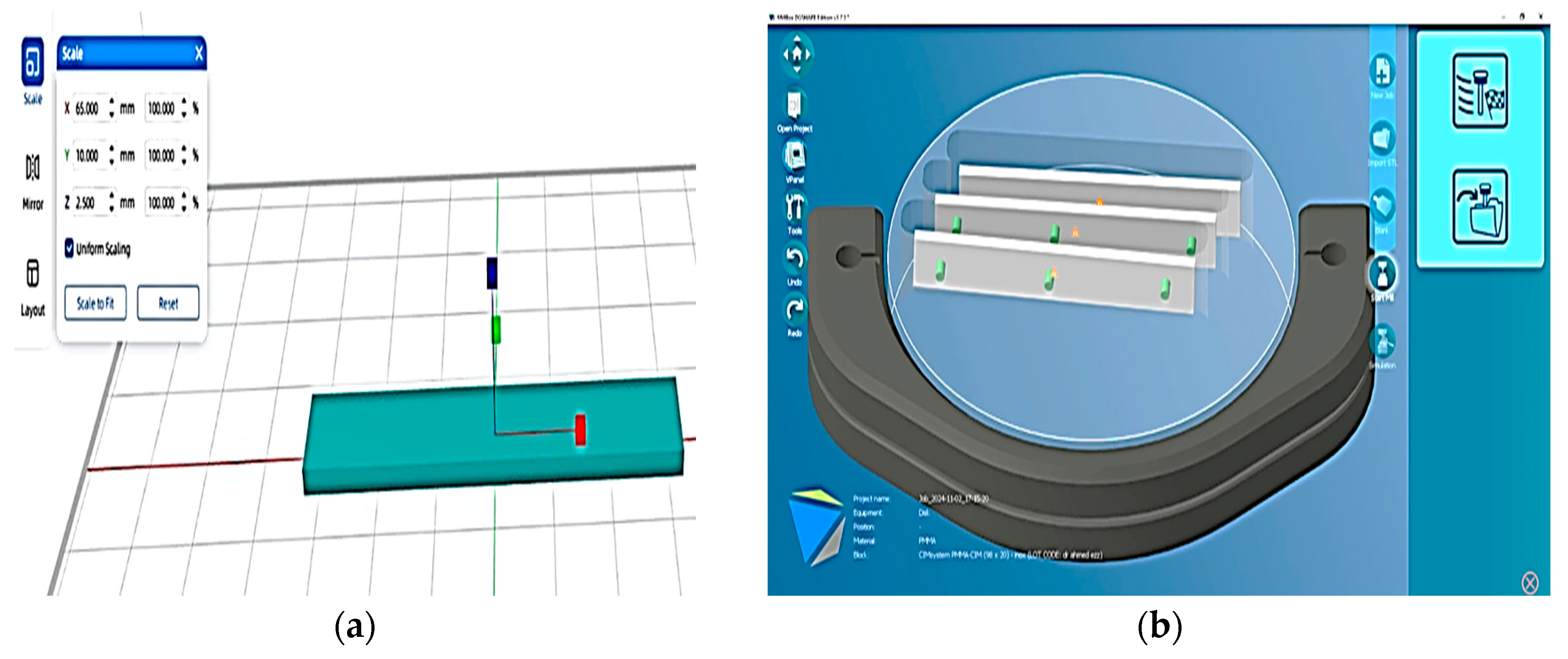
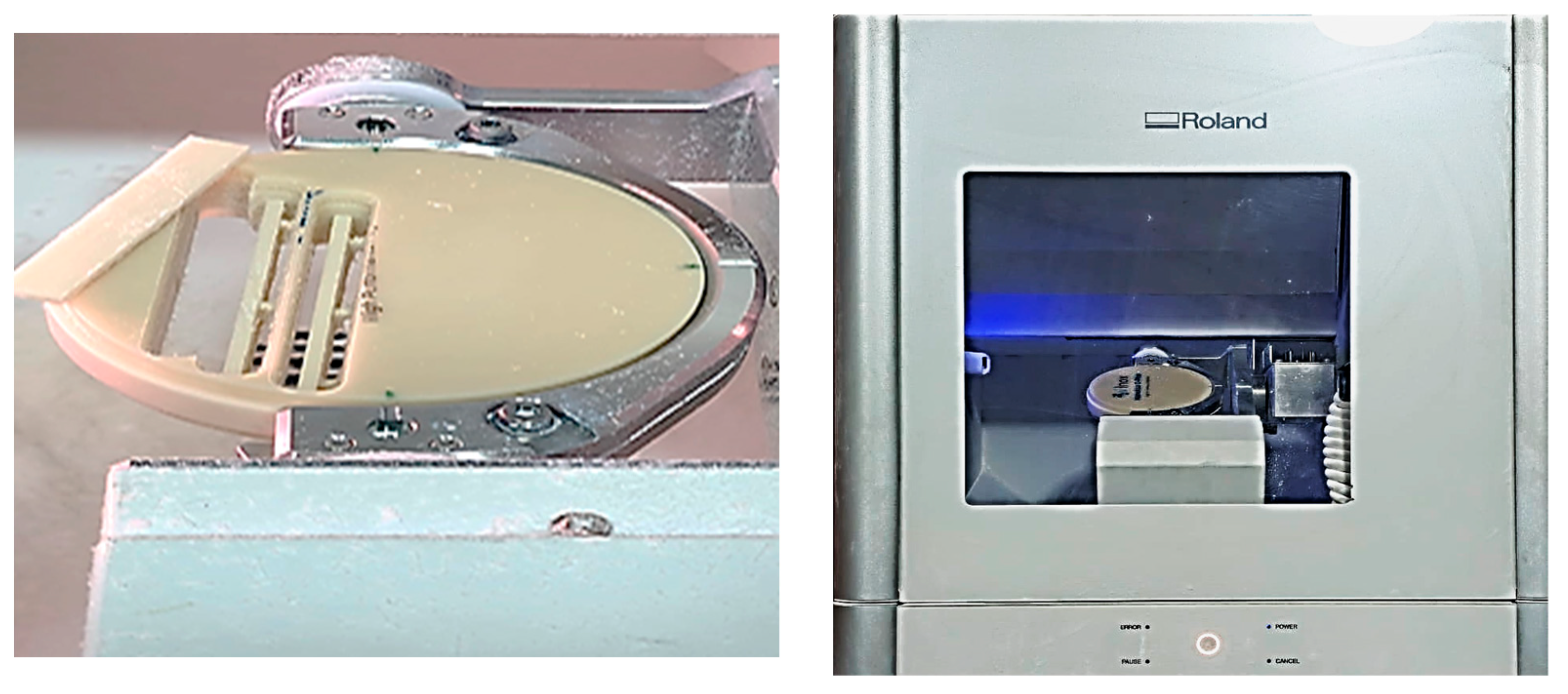
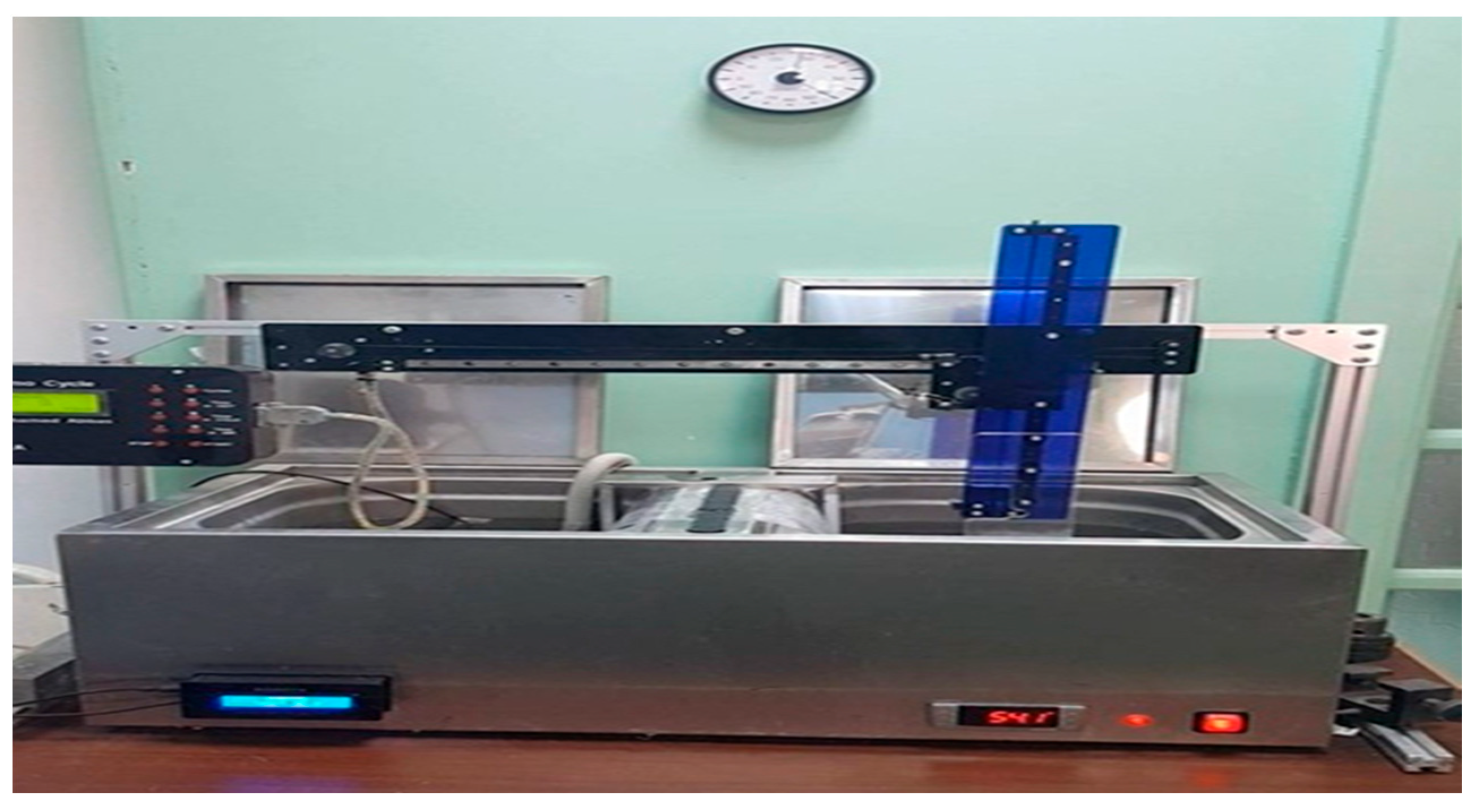
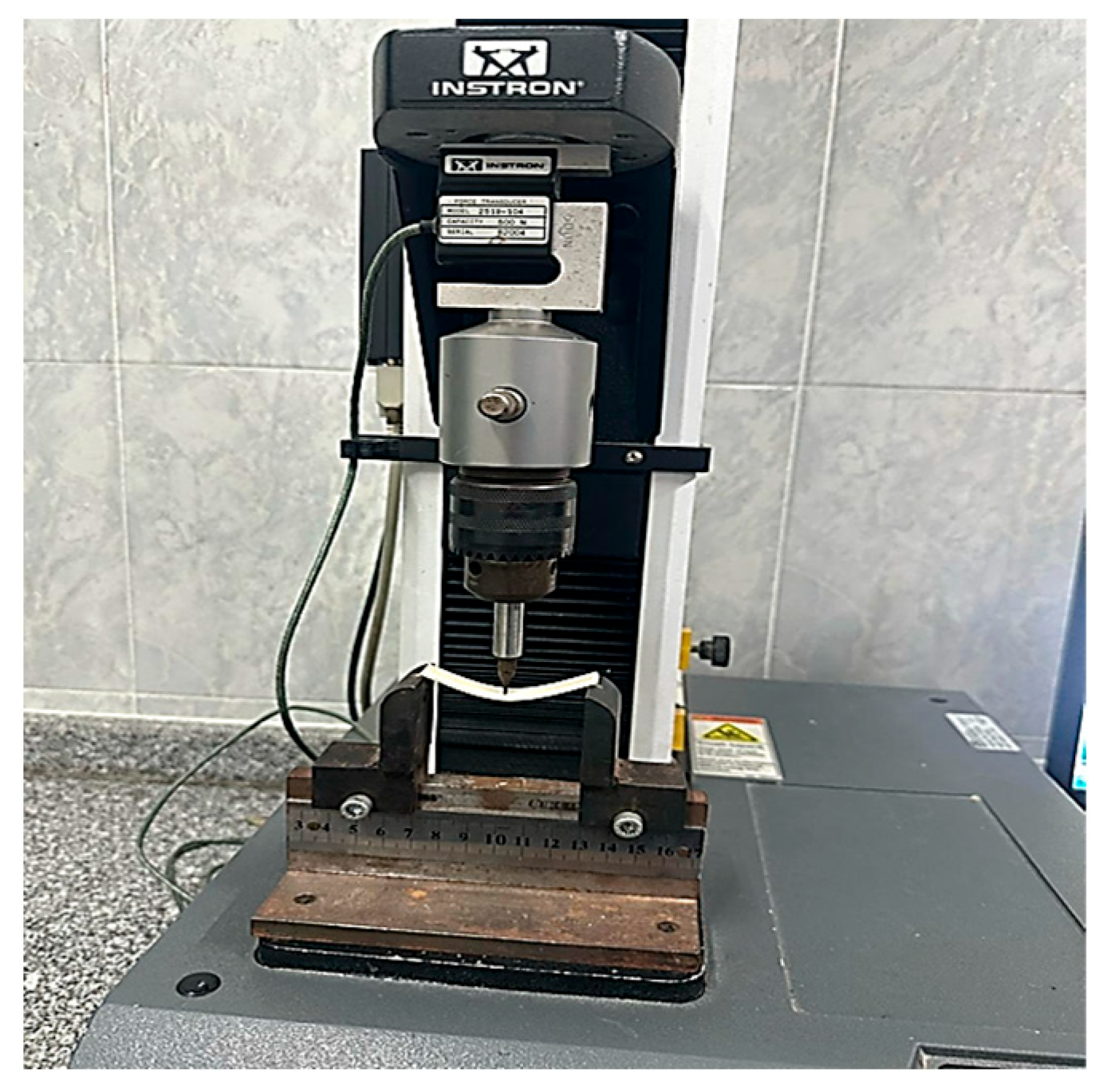
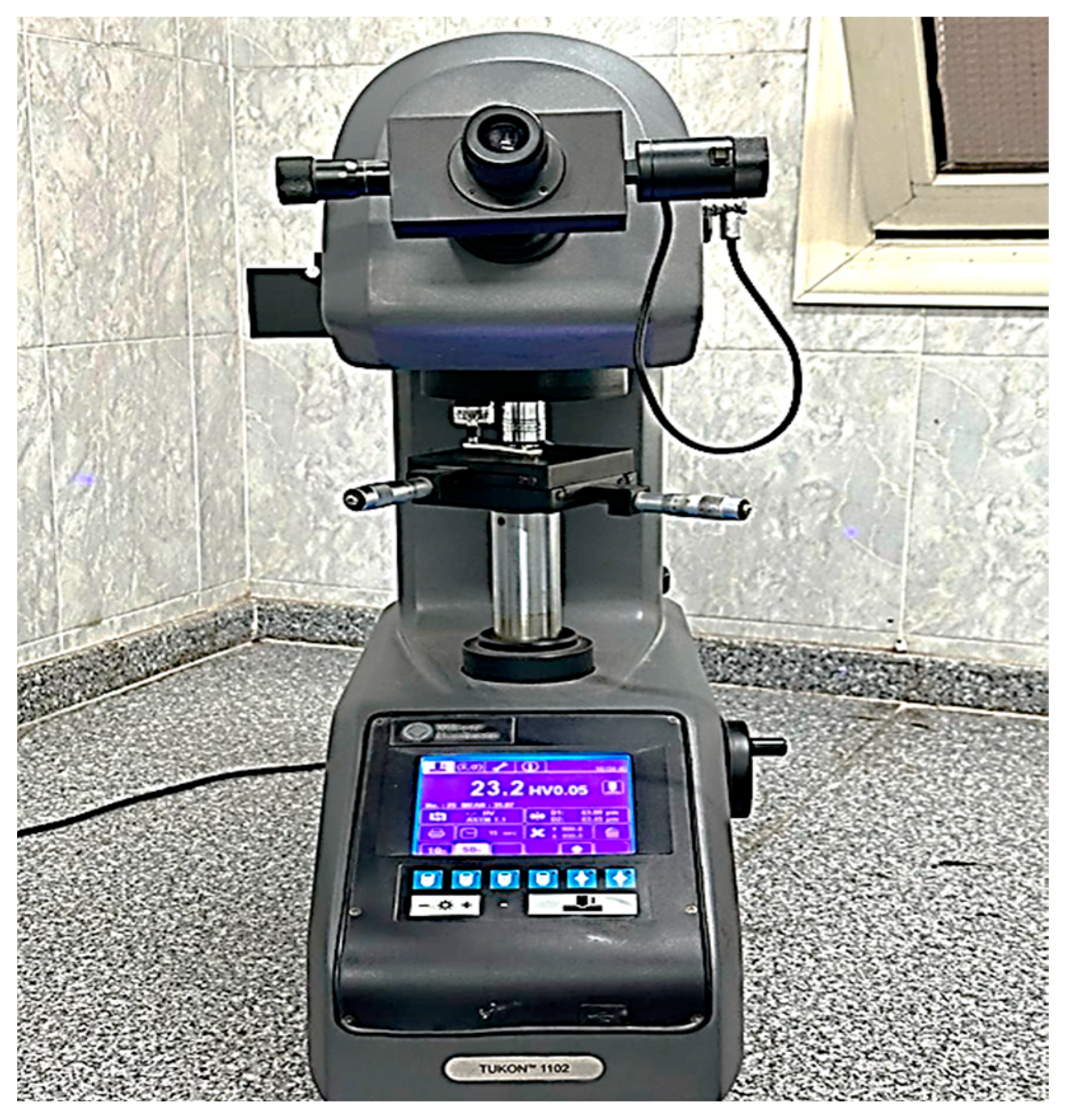
| Flexural Strength | Nanoksa G-Plus (Mean ± SD) | Bio-HPP/PEEK (Mean ± SD) | MD | T-Value | p-Value |
|---|---|---|---|---|---|
| NTA | 97.72 ± 1.27 | 126.78 ± 2.87 | −29.06 | −29.28 | <0.0001 * |
| TA | 78.71 ± 1.18 | 111.90 ± 1.83 | −33.2 | −48.20 | <0.0001 * |
| Microhardness | Nanoksa G-Plus (Mean ± SD) | Bio-HPP/PEEK (Mean ± SD) | MD | T-Value | p-Value |
|---|---|---|---|---|---|
| NTA | 17.59 ± 0.61 | 23.33 ± 0.58 | −5.74 | −21.522 | <0.0001 * |
| TA | 12.61 ± 0.75 | 19.43 ± 0.64 | −6.82 | −21.63 | <0.0001 * |
| Flexural Strength | NTA (Mean ± SD) | TA (Mean ± SD) | MD | T-Value | p-Value |
|---|---|---|---|---|---|
| Nanoksa G-Plus | 97.72 ± 1.27 | 78.71 ± 1.18 | −13.83 | −5.63 | <0.001 * |
| Bio-HPP/PEEK | 126.78 ± 2.87 | 111.90± 1.83 | −11.62 | −5.33 | <0.001 * |
| Microhardness | NTA (Mean ± SD) | TA (Mean ± SD) | MD | T-Value | p-Value |
|---|---|---|---|---|---|
| Nanoksa G-Plus | 17.59 ± 0.61 | 12.61 ± 0.75 | −4.93 | −3.20 | 0.007 * |
| Bio-HPP/PEEK | 23.33 ± 0.58 | 19.43 ± 0.64 | −4.109 | −2.67 | 0.019 * |
Disclaimer/Publisher’s Note: The statements, opinions and data contained in all publications are solely those of the individual author(s) and contributor(s) and not of MDPI and/or the editor(s). MDPI and/or the editor(s) disclaim responsibility for any injury to people or property resulting from any ideas, methods, instructions or products referred to in the content. |
© 2025 by the authors. Licensee MDPI, Basel, Switzerland. This article is an open access article distributed under the terms and conditions of the Creative Commons Attribution (CC BY) license (https://creativecommons.org/licenses/by/4.0/).
Share and Cite
Abdelrahim, R.A.; Ezzeldine, A.A.; Abdellah, M.; Elghazawi, S.S. Effect of Thermal Ageing on Flexural Strength and Microhardness of Novel High-Performance Polymer (Nanoksa G-Plus) in Comparison to a Widely Used Bio-HPP/PEEK. Dent. J. 2025, 13, 370. https://doi.org/10.3390/dj13080370
Abdelrahim RA, Ezzeldine AA, Abdellah M, Elghazawi SS. Effect of Thermal Ageing on Flexural Strength and Microhardness of Novel High-Performance Polymer (Nanoksa G-Plus) in Comparison to a Widely Used Bio-HPP/PEEK. Dentistry Journal. 2025; 13(8):370. https://doi.org/10.3390/dj13080370
Chicago/Turabian StyleAbdelrahim, Ramy Abdallah, Ahmed Ali Ezzeldine, Mahmoud Abdellah, and SaadEldein Sadeq Elghazawi. 2025. "Effect of Thermal Ageing on Flexural Strength and Microhardness of Novel High-Performance Polymer (Nanoksa G-Plus) in Comparison to a Widely Used Bio-HPP/PEEK" Dentistry Journal 13, no. 8: 370. https://doi.org/10.3390/dj13080370
APA StyleAbdelrahim, R. A., Ezzeldine, A. A., Abdellah, M., & Elghazawi, S. S. (2025). Effect of Thermal Ageing on Flexural Strength and Microhardness of Novel High-Performance Polymer (Nanoksa G-Plus) in Comparison to a Widely Used Bio-HPP/PEEK. Dentistry Journal, 13(8), 370. https://doi.org/10.3390/dj13080370





